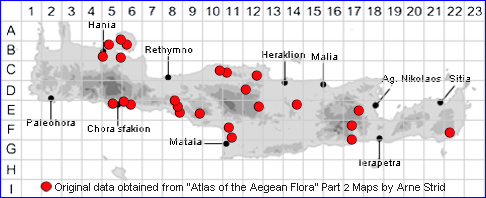

SPECIES DESCRIPTION
GARIDELLA NIGELLASTRUM
Including Garidella unguicularis
Family and Genus:- See- RANUNCULACEAE
Common Names:- None
Homotypic Synonyms:- Nigella nigellastrum
Meaning:- Garidella Meaning unknown
Nigellastrum (L) Medieval Latin name for corn-cockle.
General description:- Herbaceous plant.
Stems:-
1) 30-50 cm, slender, simple or with ascending branches.
Leaves:-
1) Alternate, deeply divided, with narrow parallel-sided segments, glabrous.
2) Cauline, deeply divided into linear segments.
Flower:-
1) Solitary on long pedicels.
2) Perianth-segments, 3-4 mm, greenish, tinged purplish or reddish.
3) Honey-leaves, 7-9 mm, the claw not exserted.
4) Lower lip of the limb, oblong, narrowed at base, divided into two linear-oblong
lobes.
5) Anthers, dark brown.
Fruit:-
1) Seeds, rugose with anastomosing ridges.
Key features:-
1) Honey-leaves, 7-9 mm, oblong.
2) Anthers, dark brown.
Habitat:- Dry open shrubby vegetation, fallow fields, olive groves, gorges, roadsides
and other disturbed habitats. 0-500 m.
Distribution:- Limited distribution in the Aegean area, but widely scattered in the
Mediterranean area, eastwards to Caucasia and N Iran. Somewhat sparsely
scattered across Crete, mainly in the central areas.
Flowering time:- Apr-May.
Photos by:- Zacharias Angourakis
GARIDELLA UNGUICULARIS Back to Top
Synonyms:- Nigella unguicularis
Meaning:- Unguicularis (L) With a small claw.
Resembling Garidella nigellastrum in vegetative characters as follows:
1) Sepals slightly shorter and broader.
2) Petals with a long, slender claw.
a) lower lip of the limb, c. half as long as the claw.
b) broadly ovate, cordate at the base, shortly bifid, incurved at almost
right angles to form a roof over the follicles.
3) Anthers, yellow.
Habitat:- Dry open shrubby vegetation, scrubland vegetation and roadsides 0-500
m.
Distribution:- A rare species known from only a few locations on Crete. The only
ones in Europe. A species of E Turkey, W Syria, Palestine and Iraq, First reportÚd
from Crete by Arne Strid (1969). With a subsquent discovery in 2023 by Manolis
Petakakis in the Neo Chorio region of west Crete.
Flowering time:- May-early June
Photos by:- Manolis Petakakis
~~~~~~~~~~~~~~~~~~~~~~~~~~~~~~~~~~~~~~~~~~~~~~~~~~~~~~~~
